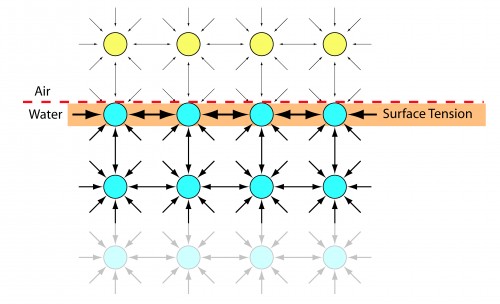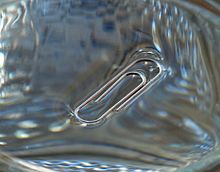The surface tension of a liquid, as we have discussed earlier, is an important consideration in the selection of cleaning chemistry for a particular application but it also has relevance in several other ways as well. In earlier blogs, I have frequently referred to the importance of surface tension but haven’t really discussed what surface tension is – an oversight on my part!
We have all witnessed the effect of surface tension.
In the above pictures, objects more dense than water are being supported by the surface tension of water. This is because their weight is distributed over a large enough area that the surface tension of the water will support them. In contrast, consider a small steel ball weighing the same as either of the above objects and similarly placed on the surface of water. The small ball, of course, would not float because its weight would be sufficiently concentrated as to overcome the forces of surface tension at the point of contact. It is obvious in both pictures above that water is being displaced at the contact points but, in fact, the weight of the water displaced will be less than the weight of the object being supported because of the surface tension forces present at the interface of the water and the air.
So what is surface tension anyway? Consider the model shown below.

Since the water molecules are more attracted to each other than they are to the contacting air, and since there must be force balance, there is a redistribution of forces at the air/water interface which makes the water molecules even more attracted to one another. This effect is surface tension.
Surface tension effects are not limited to air and water. Other liquids also have surface tension. The extent of the effect depends on the liquid and the material that it interfaces with.
It is surface tension that is responsible for the meniscus formed at the interface between a liquid and a surface. The meniscus reveals the difference between the attraction forces within the liquid and those holding the liquid to the surface. In previous blogs, several cleanliness tests were discussed that are based on surface tension effects. Please reference the following – –
Is It Clean? – Oil and Hydrophobic Films – Contact Angle and Beyond
The contact angle (in a sense) is a measure of the differential surface tension between that of the droplet of liquid and the surface to which it is applied. A large contact angle indicates a surface that is not strongly bonded to a liquid while a small contact angle indicates a surface with a bonding effect that may approach that of the surface tension of the liquid. In the case of using contact angle as a measure of cleanliness it is assumed that the contact angle will increase as the amount of contaminant on the part surface (usually oil) increases. Clearly, this test would not apply if the surface being tested is, itself, one that rejects water (hydrophobic).
In all cases, surface tension effects are the result of balancing of forces to the lowest possible energy level. Surface tension, for example, is responsible for the fact that water droplets form in a similar fashion as balloons (unless intentionally shaped otherwise) are round (the rubber of the balloon acts in a way similar to that of surface tension).
Although when selecting a cleaning chemistry we usually look for a liquid with low surface tension there are occasions where high surface tension can be equally as beneficial. One case is that of “slow-pull” drying of parts which will be discussed in an upcoming blog.
– FJF –



 English
English Spanish
Spanish Chinese
Chinese Canada
Canada Mexico
Mexico United Kingdom
United Kingdom





